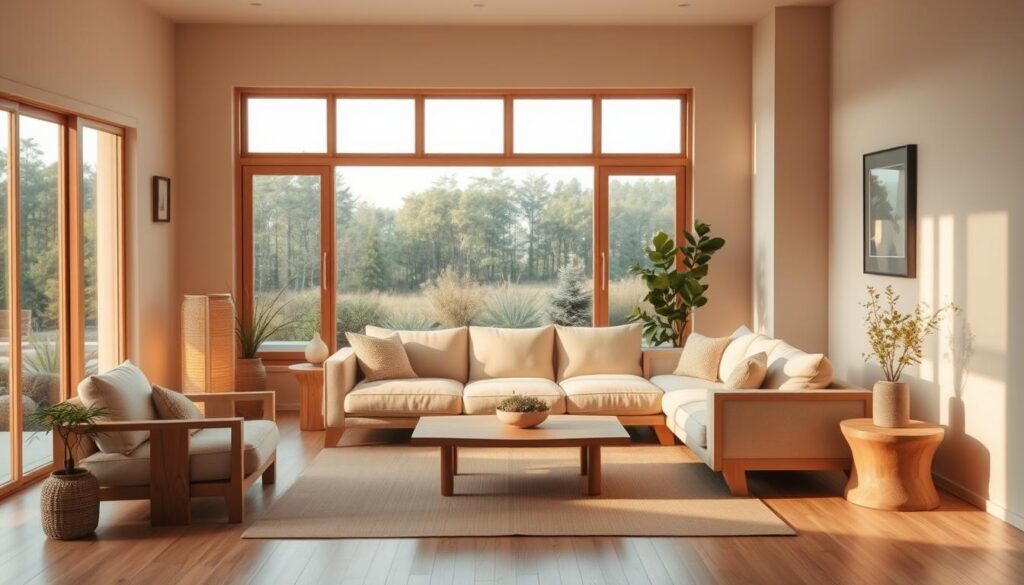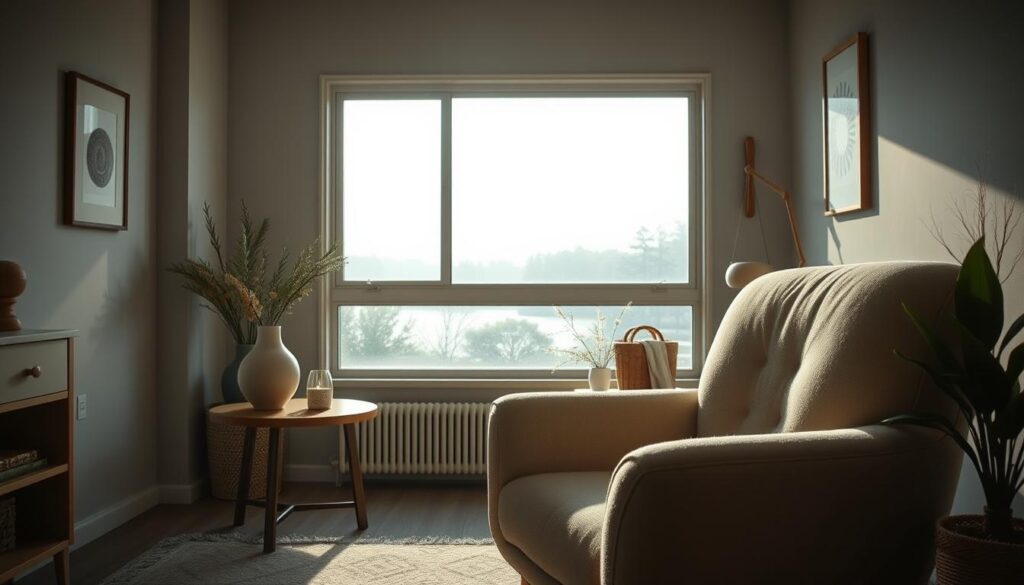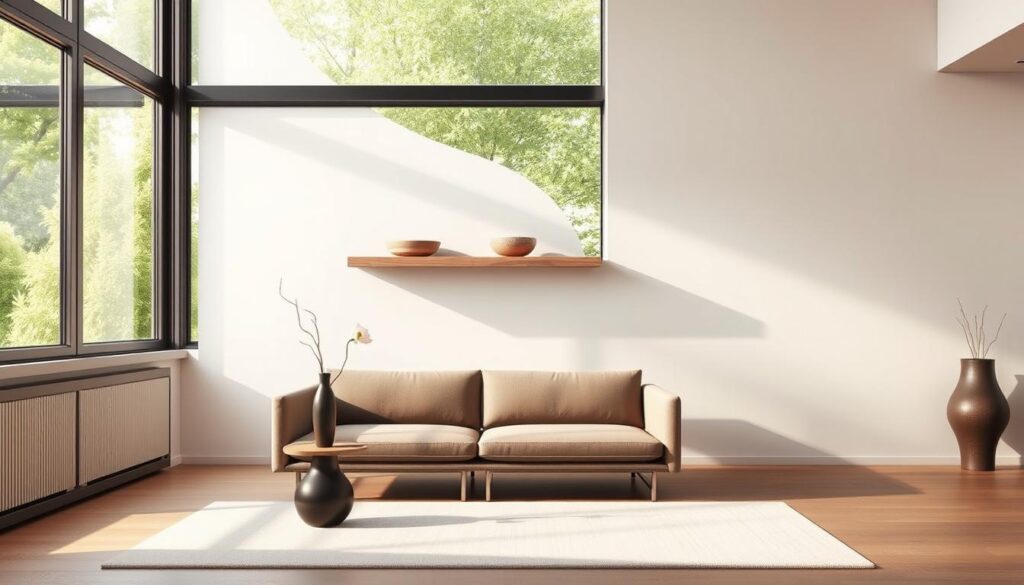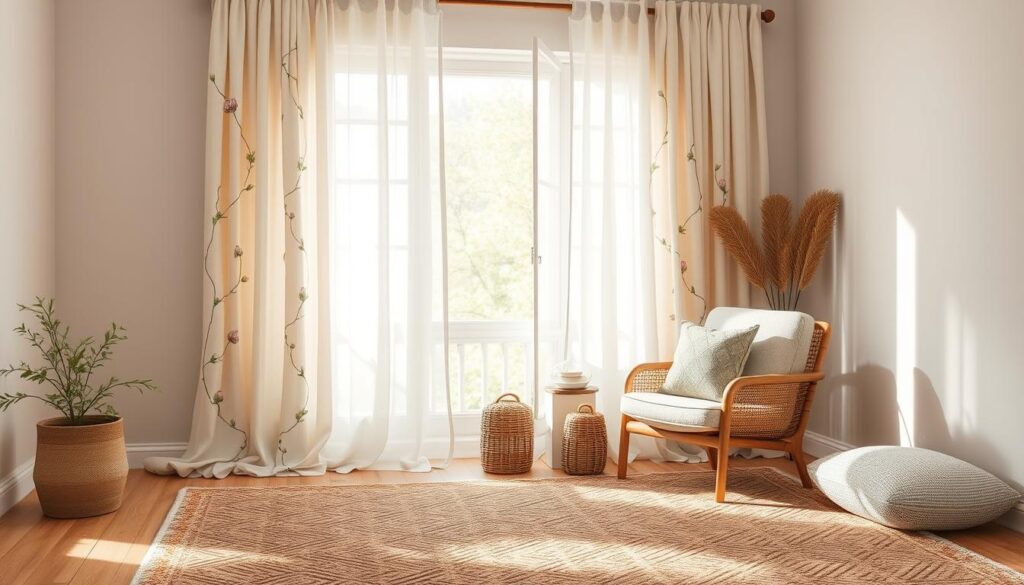Transforming your home into a peaceful retreat doesn’t require a full remodel. By embracing zen principles—simplicity, balance, and harmony—you can craft a calming space with minimal effort. Whether you live in a Tampa bungalow or a city apartment, these small adjustments make a big impact.
Intentional design choices help reduce stress and improve focus. Natural light, clutter-free surfaces, and organic textures connect you to nature. Even small changes, like rearranging furniture or adding plants, foster tranquility.
This guide covers five achievable steps. No major renovations are needed—just thoughtful tweaks to elevate your daily life. Let’s explore how to blend function and serenity effortlessly.
Key Takeaways
- Zen decor emphasizes simplicity and balance.
- Small changes create a calming atmosphere.
- Natural elements enhance relaxation.
- Clutter reduction improves mental clarity.
- Affordable updates yield noticeable results.
Introduction to Zen Home Design
Japanese-inspired design blends function with serenity. Rooted in mindfulness, it prioritizes simplicity and purpose over excess. Whether a studio apartment or a suburban home, this approach creates harmony.

Zen principles focus on what truly matters. Clutter-free space reduces distractions, letting you breathe. Natural materials like wood and stone connect you to the earth.
Key elements define this style:
- Wabi-sabi: Embracing imperfections as beauty.
- Visual balance: Symmetry and open areas.
- Intentionality: Every item serves a purpose.
Modern lifestyles often drown in noise and stuff. Zen interiors offer a quiet counterpoint. Brands like Bari Decor show how these ideas work in living rooms, bedrooms, and even kitchens.
A calm environment isn’t just pretty—it’s restorative. Light, texture, and layout work together. The result? A sanctuary that feels both grounded and uplifting.
1. Declutter for Simplicity (The Core of Zen)
Neuroscience confirms clutter disrupts mental clarity—time to reset. Visual chaos triggers stress hormones, while organized space fosters focus. Start small: one drawer, one shelf. Progress fuels motivation.

Embrace the KonMari Method
Marie Kondo’s approach isn’t just tidying—it’s curating joy. Hold each item: does it spark happiness? If not, thank it and let go. Here’s how to apply it:
- Category order: Clothes > books > papers > misc > sentimental.
- Vertical folding: Saves space and reveals all items at once.
- Designated homes: Assign spots to keep simplicity sustainable.
Choose Neutral Color Palettes
Soft whites, beiges, and grays aren’t just trendy—they’re calming. Studies show neutral tones lower cortisol levels. Pair with natural textures for warmth:
| Color | Effect | Best For |
|---|---|---|
| Warm White | Inviting, airy | Small rooms |
| Soft Gray | Balanced, modern | Home offices |
| Beige | Cozy, earthy | Bedrooms |
Furniture with Clean Lines
Sleek designs enhance simplicity. Opt for pieces like minimalist seating from West Elm or IKEA’s LISABO series. Key features:
- Low profiles: Create open sightlines.
- Multifunctional: Storage ottomans, nesting tables.
- Natural materials: Oak, linen, rattan.
Before decluttering, a room feels heavy. After? Light flows freely. That’s the power of intentional space.
2. Maximize Natural Light
Brightening your home starts with harnessing daylight effectively. Natural light elevates mood, reduces eye strain, and makes any space feel larger. These strategies amplify sunlight without costly renovations.

Sheer Curtains vs. Heavy Drapes
Sheer fabrics diffuse sunlight softly, maintaining privacy while brightening rooms. Heavy drapes block 70% more light—ideal for bedrooms but counterproductive elsewhere. For layered control, pair sheer panels with blackout liners.
Strategic Mirror Placement
Mirrors double sunlight by reflecting it deeper into your home. Angle them opposite windows or in dim hallways. A large floor mirror leaning against a wall adds design flair while bouncing light.
Energy-Efficient Window Upgrades
ENERGY STAR® windows offer a 12% ROI by cutting cooling costs—key in Tampa’s heat. Hurricane-resistant laminated glass maintains clarity while protecting your environment. Pro tip: Trim outdoor foliage to unblock light paths.
“Daylight regulates cortisol levels, improving sleep and focus.”
Even small tweaks, like swapping curtains or adding mirrors, transform your space. Prioritize changes that align with your climate and daily rhythms.
3. Easy Zen House Aesthetic Tips with Natural Elements
Bringing nature indoors transforms any room into a peaceful retreat. Natural elements like plants, wood, and water features bridge the gap between your space and the outdoors. These touches reduce stress and boost mindfulness effortlessly.

Low-Maintenance Plants for Clean Air
Bamboo and succulents purify air while adding life to your decor. NASA’s Clean Air Study highlights their toxin-removing benefits. Here are the top picks for busy homeowners:
| Plant | Care Level | Air-Purifying Score |
|---|---|---|
| Snake Plant | Beginner | High |
| Bamboo Palm | Moderate | Very High |
| Aloe Vera | Easy | Medium |
| Peace Lily | Low | High |
| Spider Plant | Beginner | Very High |
Wood and Stone Accents
Reclaimed wood shelves or slate coasters add earthy texture. Compare materials for different budgets:
- Slate: Durable and modern ($$).
- River rocks: Affordable for DIY projects ($).
- Teak: Weather-resistant for indoor/outdoor use ($$$).
Ethically sourced materials, like salvaged barn wood, support sustainability.
Indoor Water Features
A tabletop fountain creates soothing sounds. Research shows flowing water enhances focus. Try this simple DIY:
- Use a ceramic bowl and small pump.
- Add smooth stones for a natural look.
- Place near a window for light reflection.
“Biophilic design reduces stress by 15% by connecting us to nature.” — Journal of Environmental Psychology
These natural elements work together to craft a restorative space. Start small—a plant here, a stone accent there—and let the calm unfold.
4. Create a Dedicated Relaxation Zone
Carving out a peaceful corner in your home supports daily renewal. Even a small space can become a retreat for unwinding. Focus on comfort, simplicity, and sensory details to cultivate peace.

Floor Cushions and Low Seating
Ground-level seating encourages mindful posture. Compare cushion densities for optimal support:
- Buckwheat hulls: Firm, molds to your shape (best for long meditation).
- Memory foam: Soft yet supportive (ideal for beginners).
- Kapok fiber: Lightweight and eco-friendly (great for travel).
Pair with a low wooden bench or rattan mat for a layered look.
Tech-Free Meditation Corner
Designate a space free from screens. Try this digital detox checklist:
- Silence notifications with a physical timer.
- Add a mandala tapestry for visual focus.
- Use noise-canceling curtains for urban environments.
“Separating work and meditation areas improves mental clarity.” — Mindfulness Research Journal
Aromatherapy with Essential Oils
Scents like lavender and bergamot reduce stress by 27%. Skip candles—opt for safer LED diffusers. Top blends:
| Blend | Effect |
|---|---|
| Lavender + Cedarwood | Deep relaxation |
| Bergamot + Ylang-Ylang | Uplifting calm |
Layer these elements to craft a relaxation zone that feels both intentional and inviting.
5. Soft Lighting for Ambiance
Lighting shapes mood more than we realize—subtle adjustments create instant calm. Warm, layered lighting reduces eye strain while enhancing atmosphere. From dimmers to candles, each element contributes to a restful environment.

Dimmable LED Bulbs
Choose bulbs by Kelvin (K) temperature for different activities:
| Kelvin | Color | Best Use |
|---|---|---|
| 2700K | Warm white | Bedrooms, relaxation |
| 3000K | Soft white | Kitchens, home offices |
| 4000K | Cool white | Task lighting |
Smart bulbs like Philips Hue sync with sunrise/sunset cycles. Voice-controlled dimmers let you adjust brightness without leaving your chair.
Paper Lanterns and Candles
Flame-free options ensure safety without sacrificing atmosphere. Top LED candle brands:
- Luminara: Realistic flickering effect
- Homemory: Remote-controlled timers
- Vont: Waterproof for outdoor use
Cluster 3-5 lanterns at varying heights for visual interest. Place near mirrors to amplify their glow.
Layered Lighting Techniques
Combine three types for balance:
- Ambient: Overhead fixtures (30-50 lux for meditation)
- Task: Directional lamps (200 lux for reading)
- Accent: Spotlights on art or plants
“Warm lighting lowers cortisol 19% faster than cool tones.” — Journal of Environmental Psychology
These strategies transform harsh rooms into havens of serenity. Start with one change—perhaps dimmers or a lantern cluster—and notice the shift.
6. Minimalist Decor with Intention
Intentional decor choices shape more than just visual appeal—they cultivate daily calm. A minimalist approach focuses on quality over quantity, where each item serves a purpose or sparks joy. This philosophy transforms rooms into mindful spaces that breathe.

Wabi-Sabi Imperfections
The Japanese concept of wabi-sabi finds beauty in natural flaws. Cracked pottery repaired with gold (kintsugi) celebrates an object’s history rather than hiding damage. Apply this mindset:
- Choose handmade ceramics over mass-produced perfection
- Leave wood grains visible rather than high-gloss finishes
- Mix aged textures like linen with modern pieces
“Wabi-sabi reminds us that wear tells a story—one worth honoring.”
Single Statement Art Piece
One bold artwork creates focus without visual noise. Affordable options include:
- Local artist prints from Etsy
- Framed textile wall hangings (like these boho designs)
- DIY abstract canvases using natural pigments
Placement matters. Hang at eye level where sightlines naturally rest.
Functional Storage Solutions
Hidden organization maintains functionality without sacrificing style. Compare popular options:
| Solution | Capacity | Best For |
|---|---|---|
| Bari Decor Ottoman | 18 lbs | Living room blankets |
| Floating Shelves | 25 lbs/shelf | Books and decor |
| Under-Bed Bins | 40L volume | Seasonal clothing |
Follow the 20/20 rule: if you use it less than once every 20 days, store it out of sight. Negative space in Zen interiors isn’t empty—it’s deliberately restful.
7. Textiles That Enhance Serenity
Soft fabrics and thoughtful materials shape a peaceful environment. The right textiles—from breathable linens to plush rugs—add layers of comfort while reducing sensory overload. Research shows organic fabrics lower stress by 23% compared to synthetics.

Organic Cotton and Linen
Natural fibers regulate temperature and improve air quality. Look for OEKO-TEX® certified fabrics, free from harsh dyes. Compare thread counts for optimal use:
| Fabric | Thread Count | Best For |
|---|---|---|
| Organic Cotton | 200–400 | Bedding, curtains |
| Linen | 80–150 | Summer throws, tablecloths |
Rotate heavier linens in winter with lightweight cotton for summer. This balances comfort year-round.
Neutral-Toned Rugs
Earthy colors like sand or slate create visual harmony. Size matters—ensure rugs extend 18–24 inches beyond furniture. Top picks:
- 5×8 ft: Anchors seating areas
- 8×10 ft: Defines open layouts
- Jute or wool: Durable and soft underfoot
Weighted Blankets for Comfort
Choose blankets weighing 7–12% of your body weight. The pressure mimics a hug, reducing anxiety. Features to consider:
- Glass beads: Even weight distribution
- Removable covers: Machine-washable
- Bamboo fabric: Cool and hypoallergenic
“Weighted blankets increase melatonin production by 32%, aiding deeper sleep.” — Sleep Health Journal
8. Balance and Harmony in Layout
Flow and function define a truly calming space. How you arrange furniture impacts energy and mood. Tampa homes often use open layouts to create visual harmony while maintaining purpose.

Applying Feng Shui Principles
The Bagua map divides rooms into nine life areas. Align these zones with your floor plan:
- Career (North): Add flowing water elements
- Health (Center): Keep clutter-free
- Relationships (Southwest): Use paired decor items
“Feng shui isn’t superstition—it’s spatial psychology that honors how environments affect us.”
Symmetrical vs. Asymmetrical Design
Bookcases showcase both styles effectively:
| Style | Visual Effect | Best For |
|---|---|---|
| Symmetrical | Formal, orderly | Home offices |
| Asymmetrical | Dynamic, relaxed | Living rooms |
The rule of thirds creates pleasing asymmetry. Group items in odd numbers with varied heights.
Optimal Furniture Spacing
Breathing room improves movement and harmony. Follow these measurements:
- 30″ clearance for walkways
- 36″ between seating groups
- 42″ diameter for conversation circles
For wheelchair accessibility, maintain 60″ turning circles. Zen gardens teach us that empty space holds as much value as filled areas.
When balance guides your layout, rooms feel both grounded and inviting. Start with one high-traffic area and observe the difference.
Conclusion: Your Zen Sanctuary Awaits
Small shifts in daily surroundings foster lasting calm. By decluttering, maximizing light, and adding natural touches, your home becomes a haven. Each step—whether a plant or a dimmer switch—builds toward peace.
Start small. Swap heavy drapes for sheers. Try a weekly decluttering ritual. Tampa locals can explore The Lotus Pond for guided meditation.
Mindful design isn’t about perfection. It’s crafting a life that feels lighter. Your sanctuary is ready—one intentional change at a time.

